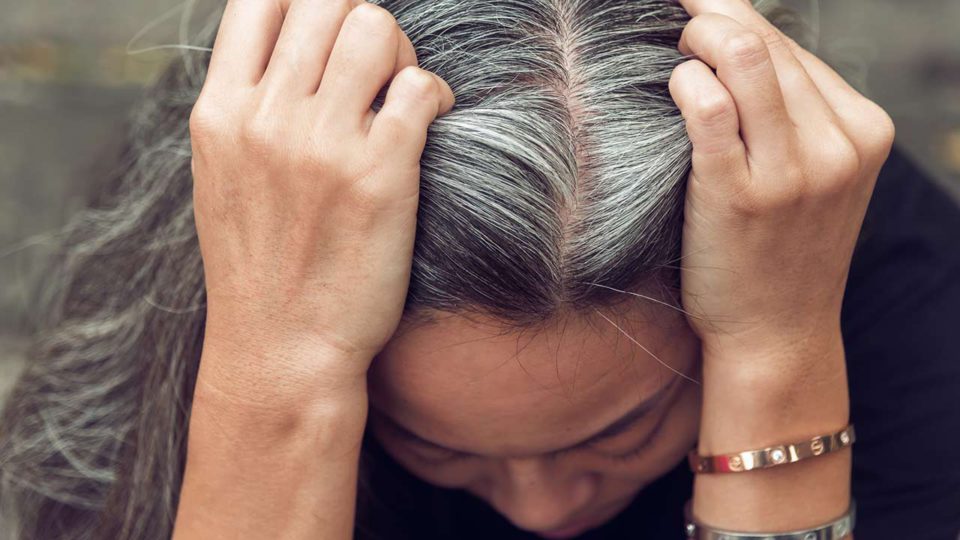We’ve always thought that gray hair is inevitable…but is it? New research shows that silver strands may actually be preventable, and reversible.
A study published in Nature focused on cells in the skin of mice that are also found in humans called melanocyte stem cells (the main mechanism that produces melanin, the substance that produces hair, skin, and eye pigmentation).
Over time, as hair ages, sheds, and grows back, melanocyte stem cells may eventually stop moving like they used to, failing to reach the part of the process where pigment is created and hair color developed. These cells get stuck as people age in what’s called the hair follicle bulge. This leads to the cells losing their ability to mature and maintain hair color, which leads to hair becoming gray, silver, and the like.
In this new study, researchers proved that this hair follicle bulge happens and determined that moving melanocyte stem cells to their proper location, where they continue to mature and generate pigment, could prevent graying.
“Our study adds to our basic understanding of how melanocyte stem cells work to color hair,” study lead investigator Qi Sun, a postdoctoral fellow at NYU Langone Health, said in a press release. “The newfound mechanisms raise the possibility that the same fixed-positioning of melanocyte stem cells may exist in humans. If so, it presents a potential pathway for reversing or preventing the graying of human hair by helping jammed cells to move again between developing hair follicle compartments.”
If you aren’t looking to fend off the grays, there are plenty of people also in that camp that embrace their silver strands (take Andie MacDowell and Helen Mirren, for example), but you’ll still want to pay attention to this study as it actually shows promise in another area: cancer.
Melanocytes are also the cell types that proliferate uncontrollably in melanoma, a dangerous skin cancer, Oma Agbai, M.D., board-certified dermatologist and director of Multicultural Dermatology and Hair Loss Disorders at the UC Davis Medical Center, notes.
“We are interested in how stem cells residing in our body are regulated to properly maintain our body and how they can reform the tissues when they are lost by injuries,” Mayumi Ito, a professor at NYU Langone Health and a senior investigator on the study, told NPR.
“When the stem cell regulation goes awry, we will have multiple health problems including cancers,” she told the outlet. “The melanocyte stem cell system is advantageous to understand this broad issue in medical science, as the malfunction of the system is so visible.”
Wait, why does hair go gray?
Hair does not actually change color once it has grown out of the follicle. However, as new hair grows from aging follicles, the pigment cells become less active over time and are less likely to produce pigment in older people, says Rebecca Marcus, M.D., board-certified dermatologist with North Dallas Dermatology Associates. “This usually happens gradually, and most often begins after age 35.”
But, these stem cells aren’t the only factor. Genetics play a big part in the age at which someone begins to go gray, and silver strands are often age-related, says Dr. Marcus. “In some cases, though, a medical condition such as a thyroid disorder, neurofibromatosis, vitamin B12 deficiency, or vitiligo may cause hair to gray prematurely.”
Studies have also shown that oxidative stress caused by environmental factors such as UV radiation, pollution, and even emotional stress can lead to premature failure of melanocytes within hair follicles, Dr. Marcus adds—a.k.a. going gray at an early age.
The bottom line
This study suggests that the differentiated melanocyte stem cells can receive signals to move backward in their development into dedifferentiated stem cells, says Dr. Agbai.
“When new stem cells are developed, they proceed to differentiate into more pigment-producing cells, which can lead to new melanin production of the hair and subsequent pigmentation of the hair,” Dr. Agbai explains. If this can be replicated in live humans, it may be possible to re-pigment hair that has been depigmented, meaning reversing gray hair.
While this new revelation can be exciting for those who prefer their original hue, the research still has a way to go before you can count on preventing or reversing grays. “Human safety data must be proven and FDA approved before such medications can be used safely,” Dr. Agbai notes. So, take these findings with a grain of salt (and pepper).
But it is exciting, as there is evidence that depigmentation of hair leading to graying may be at least partially reversible, says Dr. Agbai. “The cited study is a basic science study done in a lab, so we may be far from clinical trials in humans that prove that there is a drug that can reverse hair graying.”
At the end of the day, there is no quick fix…yet. So, be wary of any miracle drug that claims to restore your colored hair. “Be careful about any non-FDA-approved medications or supplements claiming to reverse hair graying by potentiating melanocyte stem cells,” says Dr. Agbai.
And in the meantime, if you’re looking to make the most of your grays, check out some of the best shampoos for gray hair.


